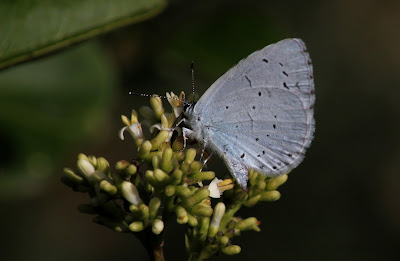The recording area is not noted for its uncommon or rare breeding species of butterflies but it more than makes up for this in terms of abundance. Common Blues, Small Coppers, Gatekeepers and Meadow Browns can all occur in very large numbers. Small Copper and Small Heaths, and to a lesser extent Common Blue, also appear in several broods through the year. Small Coppers can also appear in a number of named varieties including radiata, extensa, remota and schmidtii.
Small Coppers var schmidtii and radiata
Some species, notably Holly Blue, tend to only occur when numbers at the national level are high..
 |
Holly Blue
|
Grizzled Skipper also occur in variable numbers, although always low, and are usually one of the first species to appear in the spring.
 |
Grizzled Skipper
|
Over the last 25 years several species appear to have colonised the area. The most obvious example of this is the Marbled White. This butterfly was almost unknown in the area until 1991. Numbers have since increased so that it is now a very common insect in certain areas. The best areas to look for this species are around the Old Lighthouse and on the rough ground in front of the Observatory. The Brown Argus is another species which has colonised the area but numbers remain quite small.
 |
| Brown Argus |
Dungeness is also well situated the receive migrant butterflies and Clouded Yellows are recorded in most years along with large numbers of Large Whites and Red Admirals and smaller numbers of Painted Ladies. The highlight of 2001 was the all too brief appearance of a Monarch on 13th October, the first Dungeness record. Another individual was seen on 27th August 2023. Large Tortoiseshells were seen in 2005, 2018 and 2023 and two were found in 2020. Swallowtails have been seen in 2005, 2006 and 2014. Long-tailed Blues were seen in 2013, 2015, 2019 and 2023.
 |
| Clouded Yellow |
 |
| Red Admiral |
 |
| Long-tailed Blue |
See below for a list of Butterflies occurring at Dungeness
Common
name
|
Latin
name
|
Status
|
SMALL
SKIPPER
|
Thymelicus
sylvestris
|
Very
common.
|
ESSEX
SKIPPER
|
Thymelicus
lineola
|
Numbers
very variable but generally uncommon.
|
LARGE
SKIPPER
|
Ochlodes
venata
|
Originally
common but numbers appear to be declining and now uncommon.
|
GRIZZLED
SKIPPER
|
Pyrgus
malvae
|
Usually uncommon
but common in 2011, 2012 and 2017.
|
SWALLOWTAIL
|
Papilio
machaon
|
One
on Sep.3rd 2005. Singles on May 16th and July 24th 2006. In 2014 there were
singles on May 17th, 29th and 31st.
|
CLOUDED
YELLOW
|
Colias
croceus
|
Uncommon
migrant.
|
BRIMSTONE
|
Gonepteryx
rhamni
|
Rare.
|
LARGE
WHITE
|
Pieris
brassicae
|
Very
common, occasionally abundant.
|
SMALL
WHITE
|
Pieris
rapae
|
Very
common.
|
GREEN-VEINED
WHITE
|
Pieris
napi
|
Uncommon.
|
ORANGE-TIP
|
Anthocharis
cardamines
|
Rare.
Two records in May 1993, two in April 1999 and one in April 2017.One on May 2nd 2019.
|
SMALL
COPPER
|
Lycaena
phlaeas
|
Very
common. Three individuals of the form radiata seen in the moat in 2015.
|
LONG-TAILED
BLUE
|
Plebejus
argiolus
|
One
on October 8th 2013 was the first Dungeness area record. One on September
1st 2015. A female on August 12th 2019. Two in 2023.
|
BROWN
ARGUS
|
Aricia
agestis
|
Formerly
rare but now common and increasing following colonisation in 1997.
|
COMMON
BLUE
|
Polyommatus
icarus
|
Very
common.
|
HOLLY
BLUE
|
Celastrina
argiolus
|
Rare.
Numbers fluctuate.
|
RED
ADMIRAL
|
Vanessa
atalanta
|
Common,
occasionally very common.
|
PAINTED
LADY
|
Vanessa
cardui
|
Uncommon
to common. 1996 was an exceptional year with counts of up to 1000 as was
2009 with counts up to 2250.
|
SMALL
TORTOISESHELL
|
Aglais
urticae
|
Common.
|
LARGE
TORTOISESHELL
|
Nymphalis
polychloros
|
One
on July 3rd and 4th 2005 and one on Apr.23rd 2018. One between March 24th and 29th 2019. Singles on April 11th. and 22nd. 2020. One on June 22nd and 23rd 2023.
|
CAMBERWELL BEAUTY
|
Nymphalis
antiope
|
Rare.
The only recent records are of singles on Aug.3rd and 24th 1995.
|
PEACOCK
|
Inachis
io
|
Common.
|
COMMA
|
Polygonia
c-album
|
Uncommon.
|
SPECKLED
WOOD
|
Pararge
aegeria
|
Formerly
uncommon but numbers have increased annually in recent years and common
since 2004.
|
WALL
|
Lasiommata
megera
|
Formerly
uncommon but now rare.
|
MARBLED
WHITE
|
Melanargia
galathea
|
Formerly
rare, now common or very common following colonisation since 1991.
|
GATEKEEPER
|
Pyronia
tithonus
|
Very
common.
|
MEADOW
BROWN
|
Maniola
jurtina
|
Abundant.
|
RINGLET
|
Aphantopus
hyperantus
|
Rare.
Only recorded in 2000.
|
SMALL
HEATH
|
Coenonympha
pamphilus
|
Very
common, occasionally abundant.
|
MONARCH
|
Danaus
plexippus
|
Rare.
One on Oct.13th 2001 and one on Aug.22nd 2023.
|
|
|
KEY
|
Abundant
|
Peak
counts over 500
|
Very
common
|
Peak
counts between 100-500
|
Common
|
Peak
counts between 10-100
|
Uncommon
|
Peak
counts less than 10
|
Rare
|
Less
than annual
|
|







